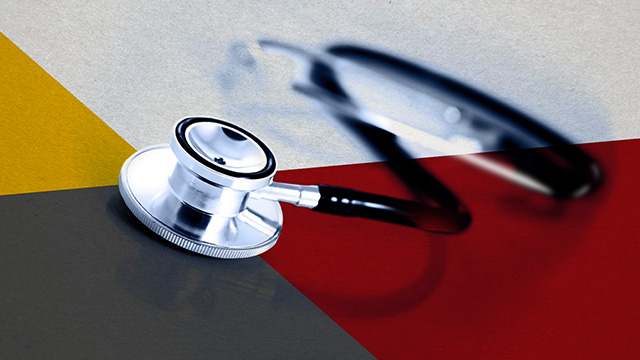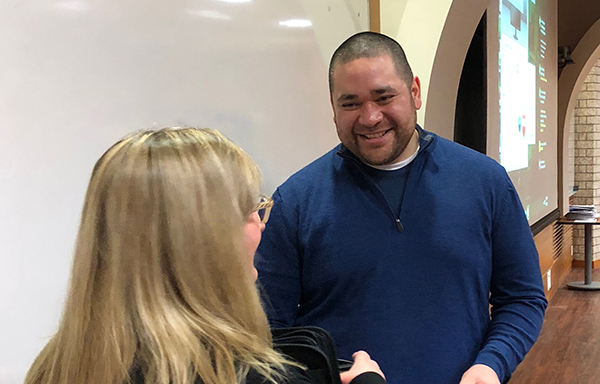
In medicine, the term 'scotoma' is used to define what we commonly know as a 'blind spot'-a partial loss of vision within a normal visual field. But what happens when the blind spot is not physical? On February 6, Alika Lafontaine, Ojibwe anesthesiologist and clinical lecturer in the Faculty of Medicine & Dentistry, shared his perspectives on how to find our 'intellectual scotoma' and the impact it may have on the health care received by generally excluded populations.
In this lecture, organized by the Indigenous Health Initiatives Program (IHIP), Lafontaine said that "we can see something, but somehow not see it at the same time." Everybody has those blind spots or unconscious biases, which are assumptions or perceptions about others that have an effect on social and professional interactions.
"Even when we are aware, we still apply these perceptions and it is much more likely to happen if we're stressed or emotional, this is just human nature," said Lafontaine. "It has nothing to do with people being weak, or not caring. This is just how we're wired."
"Unconscious bias helps us make sense of the world and can't be eliminated-that's what new research is showing us. It can only be managed."

Alika Lafontaine
The impact of interrogating the truth
Lafontaine shared personal insights and stories, as well as anonymized audio of Indigenous patients who share their experiences with medical visits and procedures. Unconscious bias, he said, increases the likelihood of situations like racial profiling, influencing the way people are approached in health-care settings, from procedures of diagnosis to treatment options. Lafontaine's concept of 'intellectual scotoma' applies to a variety of complex social issues like racism, ageism and sexism, to name a few, as they may not always be obvious and violent.
Some of the examples he provided included how patients with the same symptoms may be treated very differently when they seek medical care because of their background and people's biases; one of them may just be assumed as drunk and sent home, while the other one may be tested for serious health conditions.
"When you look at the patients' impacts, at why all this matters, this is why. It's not about making people feel bad. This is about patients not receiving the right care. The big problem with differentials within these areas, the challenge that we have in making change, is that we don't do the same things for everybody and we create narratives that establish that this is normal."
Lafontaine added the importance of not interrogating the truth of those in need of care.
"When a patient says, 'I'm hurt,' we may disagree with other colleagues about the cause of the pain, but we can't interrogate and say the patient is not hurt. It almost comes down to the questions of 'Do you believe the patient?' 'Do you investigate (symptoms) in the same way that you would with anybody else?'"
For Lafontaine, it is vital to improve accountability in health care, but also to create ways to encourage self-reflection on people's own potential biases, and how these blind spots may be present in their areas of work.
So what can change? A path of hope, moments for reflection and momentum for action
Lafontaine shared the lessons he learned as project chair of the Indigenous Health Alliance, an initiative for health-care transformation in Indigenous areas that spanned more than 150 communities across Canada and was completed in 2017. The project addressed gaps and created best practices for Indigenous health care, propelled with government funding and working in partnership with organizations like the Canadian Medical Association, the Royal College of Physicians and Surgeons of Canada, and HealthCareCAN.
Lafontaine explained their approach to redesigning system change in the topic of Indigenous health.
Hope was defined as the first step. It is common that ideas of change are met with responses like "it can never happen." According to Lafontaine, developing hope in change and creating roots of empathy and inclusion to help people "see each other as people" are crucial steps for good ideas to gain traction.
Lafontaine emphasized the importance of sharing stories that create 'moments' for people to reflect. He explained it is important that stories don't assign blame, don't interrogate the truth of those sharing the stories, and open a safe space for every person or entity that could be seen as a stakeholder in the system to analyze these situations and their role in them. For example, sometimes people in the health-care system don't want to share stories they know because they might fear negative consequences towards them. It is important to enable safe spaces for discussion and reflection, as well as time to process the takeaways from these moments.
After moments happen, momentum is created to scale up the range of action and start thinking of what resources are available, and how changes can happen. According to Lafontaine, it is important for those who want to initiate reflection and change to understand how each organization or stakeholder can contribute in the system, what value or specific actions are in their scope to improve policy, procedures or to increase awareness of these problems.
"System change does not take a long time. But change requires to be really nuanced and specific in how we allocate what we do, and it really requires us to think about whether our actions are having an impact," concluded Lafontaine.